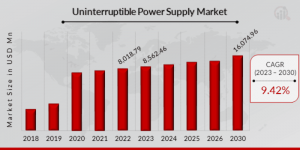Uninterruptible Power Supply Market to Grow at 9.42% CAGR Through 2030 | Siemens, ABB Ltd, Schneider Electric, Kenjitsu
Uninterruptible Power Supply Market grows with rising demand for reliable power, driven by data centers, healthcare and industrial applications
Uninterruptible Power Supply (UPS) Market Overview
The Uninterruptible Power Supply (UPS) market plays a pivotal role in maintaining critical power continuity across a wide spectrum of industries. As digital infrastructure, data centers, and automated manufacturing systems become increasingly integral to business operations, the need for reliable backup power solutions has surged. UPS systems serve as a safeguard, preventing data loss, equipment damage, and operational disruptions caused by power outages or voltage fluctuations. As of 2025, the global UPS market is experiencing robust growth, driven by the increasing demand for reliable and efficient power solutions across residential, commercial, and industrial sectors.
Get Free Sample PDF Brochure:
https://www.marketresearchfuture.com/sample_request/6623
Key Players
ABB Ltd.
Delta Power Solutions
Eaton Corporation
Emerson Electric Co.
Huawei Technologies Co., Ltd
Kenjitsu
Magellan Power
Potencia Industrial
Powershield
Riello UPS Australia Pty Ltd.
Schneider Electric
Siemens
Toshiba Corporation
Others
Market Dynamics
The dynamics of the UPS market are shaped by rapid technological advancements, rising awareness of energy efficiency, and growing digitalization. The integration of UPS systems with Internet of Things (IoT) technologies and smart energy management systems is reshaping product offerings. From basic offline models to sophisticated online double-conversion systems, manufacturers are innovating to meet diverse customer needs. Moreover, the shift towards cloud computing, the proliferation of data centers, and increased reliance on electronic equipment across all sectors have significantly increased the demand for continuous power supply systems.
Market Drivers
One of the primary drivers of the UPS market is the global expansion of data centers. With the exponential growth of data consumption and storage, especially due to the increasing use of streaming services, social media, and cloud-based applications, the need for uninterrupted power has never been greater. Data centers are among the most power-sensitive infrastructures, and even minor power interruptions can lead to significant financial and data losses. This necessity has led to substantial investments in UPS systems to ensure seamless operation.
Another critical driver is the rise of remote work and digital learning, which became particularly prominent during and after the COVID-19 pandemic. The increased reliance on home-based internet connectivity, video conferencing, and virtual education platforms has highlighted the importance of stable power supply in residential settings. Consequently, there is growing consumer demand for compact and affordable UPS systems that can ensure continuity of home offices and educational setups.
Furthermore, the increased adoption of automation and Industry 4.0 technologies in the manufacturing sector is propelling the demand for industrial-grade UPS systems. Smart factories rely heavily on uninterrupted power to maintain operations of robotics, control systems, and monitoring equipment. Any disruption can lead to costly downtime, which makes reliable power backup an essential investment.
Buy Now Premium Research Report:
https://www.marketresearchfuture.com/checkout?currency=one_user-USD&report_id=6623
Market Restraints
Despite the market’s positive outlook, certain factors act as restraints to its growth. One of the key challenges is the high initial cost associated with advanced UPS systems, especially those designed for large-scale industrial or data center applications. Small and medium enterprises, particularly in developing regions, may find the upfront investment prohibitive, which can limit market penetration.
Another restraint is the environmental impact associated with UPS systems, particularly those that use lead-acid batteries. Concerns about battery disposal, recycling, and the environmental footprint of non-renewable power sources used in some systems are prompting stricter regulations. While newer lithium-ion batteries offer better efficiency and sustainability, their higher cost is still a limiting factor for widespread adoption.
Additionally, the lack of awareness and technical knowledge about different types of UPS systems in certain developing economies hampers market growth. In many regions, there is a limited understanding of the long-term benefits and operational savings provided by UPS solutions, which results in underinvestment in these critical systems.
Uninterruptible Power Supply Market Segmentation
Uninterruptible Power Supply Rating Outlook
<5KVA
5-<50KVA
50-200KVA
>200KVA
Uninterruptible Power Supply Product Type Outlook
Off-Line/Standby
Line Interactive
Online/Double Conversion
Uninterruptible Power Supply Component Outlook
Rectifier
Batteries
Inverter
Static Bypass Switch
Capacitors
Fans
Others
Uninterruptible Power Supply Application Outlook
Telecommunication
Data Centre
Medical
Industrial
Marine
Others
Uninterruptible Power Supply Regional Outlook
North America
US
Canada
Mexico
Europe
Germany
France
UK
Italy
Rest of Europe
Asia-Pacific
China
India
Japan
South Korea
Rest of Asia-Pacific
Rest of World
Browse In-depth Market Research Report:
https://www.marketresearchfuture.com/reports/uninterruptible-power-supply-ups-market-6623
Regional Analysis
The global UPS market shows distinct regional trends, driven by varying degrees of technological advancement, industrialization, and infrastructure development.
North America remains one of the most mature and dominant markets for UPS systems. The United States and Canada have a high concentration of data centers, advanced healthcare infrastructure, and a robust IT sector, all of which require reliable power backup systems. Additionally, frequent power outages caused by extreme weather events in some parts of the region have further underlined the importance of UPS solutions for residential and commercial users alike.
Europe follows closely, with countries such as Germany, the United Kingdom, and France showing significant demand for UPS systems across manufacturing, telecommunications, and public services sectors. The European market is also benefiting from stringent regulations around energy efficiency and green technologies, encouraging the adoption of advanced, eco-friendly UPS solutions.
Asia-Pacific is currently the fastest-growing region in the UPS market, driven by rapid industrialization, urbanization, and digital transformation in countries such as China, India, and Japan. The growth of small and medium-sized enterprises, rising investment in IT infrastructure, and expanding telecommunications networks are major contributors to the regional demand. In particular, India has emerged as a hotspot due to frequent power outages and a burgeoning digital economy.
Latin America and the Middle East & Africa are also witnessing growing adoption of UPS systems, albeit at a slower pace. In these regions, the need for stable power supply is primarily driven by the expansion of commercial establishments, increasing government investment in infrastructure, and gradual digitalization. Brazil, Mexico, the UAE, and South Africa are among the leading markets in these regions.
Related Reports:
Boiler Control Market: https://www.marketresearchfuture.com/reports/boiler-control-market-6988
Pad-Mounted Switchgear Market: https://www.marketresearchfuture.com/reports/pad-mounted-switchgear-market-7855
Captive Power Generation Market: https://www.marketresearchfuture.com/reports/captive-power-generation-market-10446
Generator Sales Market: https://www.marketresearchfuture.com/reports/generator-sales-market-1524
Water Cut Monitors Market: https://www.marketresearchfuture.com/reports/water-cut-monitors-market-9018
Laminated Busbar Market: https://www.marketresearchfuture.com/reports/laminated-busbar-market-7648
Microbial Fuel Cell Market: https://www.marketresearchfuture.com/reports/microbial-fuel-cell-market-7194
About Market Research Future
At Market Research Future (MRFR), we enable our customers to unravel the complexity of various industries through our Cooked Research Report (CRR), Half-Cooked Research Reports (HCRR), Raw Research Reports (3R), Continuous-Feed Research (CFR), and Market Research Consulting Services. The MRFR team have a supreme objective to provide the optimum quality market research and intelligence services for our clients. Our market research studies by Components, Application, Logistics and market players for global, regional, and country level market segments enable our clients to see more, know more, and do more, which help to answer all their most important questions.
Market Research Future
Market Research Future
+1 855-661-4441
email us here
Visit us on social media:
LinkedIn
Facebook
X
Legal Disclaimer:
EIN Presswire provides this news content "as is" without warranty of any kind. We do not accept any responsibility or liability for the accuracy, content, images, videos, licenses, completeness, legality, or reliability of the information contained in this article. If you have any complaints or copyright issues related to this article, kindly contact the author above.
leagend BMS100 Sets New Standard for Real-Time Battery Monitoring in High-Demand Environments
AI CERTs® Launches AI+ Security Level 3™ to Equip Cyber Pros for Intelligent Threat Defense
Giant Leap Day July 20
Kalendarium
Więcej ważnych informacji
 Jedynka Newserii
Jedynka Newserii

 Jedynka Newserii
Jedynka Newserii

Prawo

KE proponuje nowy Fundusz Konkurencyjności. Ma pobudzić inwestycje w strategiczne dla Europy technologie
W środę 16 lipca Komisja Europejska przedstawiła projekt budżetu na lata 2028–2034. Jedna z propozycji zakłada utworzenie Europejskiego Funduszu Konkurencyjności o wartości ponad 400 mld euro, który ma pobudzić inwestycje w technologie strategiczne dla jednolitego rynku. Wśród wspieranych obszarów znalazła się obronność i przestrzeń kosmiczna. Na ten cel ma trafić ponad 130 mld euro, pięciokrotnie więcej niż do tej pory.
Firma
Były prezes PGE: OZE potrzebuje wsparcia magazynów energii. To temat traktowany po macoszemu

Choć udział odnawialnych źródeł energii w miksie energetycznym Polski jest stosunkowo wysoki i rośnie, to ten przyrost jest chaotyczny i nierównomiernie rozłożony miedzy technologiami – wskazuje Forum Energii. Dodatkowo OZE potrzebują wsparcia magazynów energii, a zdaniem Wojciecha Dąbrowskiego, prezesa Fundacji SET, ten temat jest traktowany po macoszemu. Brak magazynów powoduje, że produkcja energii z OZE jest tymczasowo wyłączana, co oznacza marnowanie potencjału tych źródeł.
Infrastruktura
Wzrost wynagrodzeń ekip budowlanych najmocniej wpływa na koszty budowy domu. Zainteresowanie inwestorów mimo to nieznacznie wzrasta

Budowa metra kwadratowego domu w Polsce kosztuje od 5,55 do 6 tys. zł w zależności od województwa – wynika z najnowszych analiz firmy Sekocenbud. Najdrożej jest w Warszawie, gdzie cena za metr kwadratowy domu przekroczyła już 6,2 tys. zł. Na przyrosty kosztów budowy domu wpływają zarówno drożejące materiały budowlane, jak i wyższe wynagrodzenia pracowników. Inwestorzy nie rezygnują jednak z budowy domów jednorodzinnych, co ma związek m.in. z wciąż wysokimi cenami mieszkań czy też obniżką stóp procentowych.
Partner serwisu
Szkolenia

Akademia Newserii
Akademia Newserii to projekt, w ramach którego najlepsi polscy dziennikarze biznesowi, giełdowi oraz lifestylowi, a także szkoleniowcy z wieloletnim doświadczeniem dzielą się swoją wiedzą nt. pracy z mediami.









.gif)

 |
| |
| |
|